金融机构与市场-选择题题库 学生复习 2011
- 格式:pdf
- 大小:216.98 KB
- 文档页数:59
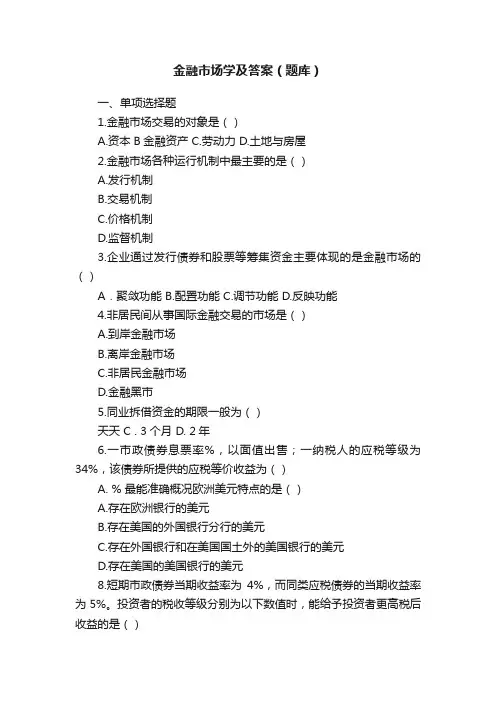
金融市场学及答案(题库)一、单项选择题1.金融市场交易的对象是()A.资本B金融资产 C.劳动力 D.土地与房屋2.金融市场各种运行机制中最主要的是()A.发行机制B.交易机制C.价格机制D.监督机制3.企业通过发行债券和股票等筹集资金主要体现的是金融市场的()A.聚敛功能 B.配置功能 C.调节功能 D.反映功能4.非居民间从事国际金融交易的市场是()A.到岸金融市场B.离岸金融市场C.非居民金融市场D.金融黑市5.同业拆借资金的期限一般为()天天 C . 3个月 D. 2年6.一市政债券息票率%,以面值出售;一纳税人的应税等级为34%,该债券所提供的应税等价收益为()A. % 最能准确概况欧洲美元特点的是()A.存在欧洲银行的美元B.存在美国的外国银行分行的美元C.存在外国银行和在美国国土外的美国银行的美元D.存在美国的美国银行的美元8.短期市政债券当期收益率为4%,而同类应税债券的当期收益率为5%。
投资者的税收等级分别为以下数值时,能给予投资者更高税后收益的是()% % %9.最早发行大额可转让定期存单是()A 汇丰银行B 中国银行C 花旗银行D 巴林银行10.国库券和BAA级公司债券收益率差距会变大的情形()A 利率降低B 经济不稳定C 信用下降D 以上均可11.以折价方式卖出债券的情形是()A 债券息票率大于当期收益率,也大于债券的到期收益率B债券息票率等于当期收益率,也等于债券的到期收益率C债券息票率小于当期收益率,也小于债券的到期收益率D债券息票率小于当期收益率,也大于债券的到期收益率12.一份10 000元面值的10年期国债每半年付息一次,该国债的年息票率6%,投资者在第5年末会收到()A 300元B 600元C 3 000元D 6 000元13.关于政府机构债券说法不正确的是()A 以信誉为保证,无需抵押品B 债券由中央银行作后盾C 债券的收支偿付列入政府的预算D 财政部和一些政府机构可发行14.最适合被证券化的是()A 企业的信用贷款B 一般的房地产抵押贷款C 住房抵押贷款D 企业的担保贷款15.一家公司的销售额和利润都快速地增长,且其速度要远远快于整个国家以及其所在的行业的发展速度,那么这家公司发行的股票属于()A 蓝筹股B 投机股C 成长股D 收入股16.在本国募集资金并投资于本国证券市场的证券投资基金是指()A 在岸基金B 离岸基金C 伞形基金D 保本基金17.我国封闭式基金上市要求基金份额持有人不少于()A 200B 500C 1 000D 2 00018.在风险调整测度指标中,用市场组合的长期平均超额收益除以该时期的标准差的是()A 夏普测度B 特雷纳测度C 詹森指数D M2测度19.期权购买者只能在期权到期日那一天行使权利,既不能提前也不能推迟的期权是()A 欧式期权B 现货期权C 期货期权D 美式期权20.标的的资产市价高于协议价格时的看涨期权称为()A 虚值期权B 场内期权C 实值期权D 场外期权21.某人某日用美元在买进50万欧元,5天后再平仓,其获利为()A 7 000美元B 7 250美元C 6 275美元D 6 750美元22.关于利率对汇率变动的影响,表述正确的是()A内利率上升,则本国汇率上升B 国内利率下降,则本国利率下降C 需比较国内外的利率和通货膨胀率后确定D 利率对汇率的影响是长期的23.下面表述正确的是()A 在直接标价法和间接标价法下,升水和贴水的含义恰恰相反B 远期外汇的买卖价之差总是大于即期外汇的买卖价之差C 买入价和卖出价是同一笔外汇交易中买卖双方所使用的价格D 在直接标价法下,汇率上升意味着本币升值24.现代货币制度下,可能使一国的汇率上升的原因有()A 政府宣布减少税收B 银行利率下降C 物价下降D 放宽对进口的限制25.弹性货币分析法强调对汇市产生影响的市场有()A 保险市场B 商品市场C 货币市场D 证券市场26.下列有关利率期限结构的说法正确的是()A.预期假说认为,如果预期将来短期利率高于目前的短期利率,收益率曲线就是水平的B.预期假说认为,长期利率等于预期短期利率C.流动性偏好假说认为,在其他条件相同的情况下,期限越长,收益率越低D.流动性偏好假说认为,不同的借款人和贷款人对收益率曲线的不同区段有不同的偏好27.假定名义年利率为10%,每年复利两次,那么,有效(年)利率为()% % 根据凯恩斯流动性偏好理论,与利率相关的是()A.交易动机B.预防动机 B.投机动机 D.以上都不对29.名义利率是8%,通货膨胀率为10%。
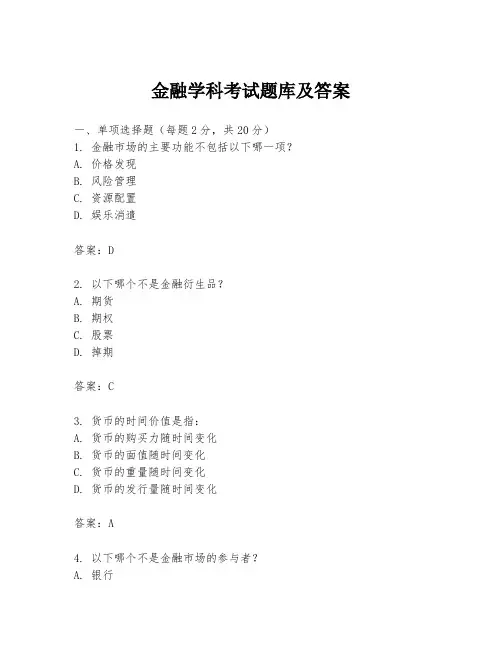
金融学科考试题库及答案一、单项选择题(每题2分,共20分)1. 金融市场的主要功能不包括以下哪一项?A. 价格发现B. 风险管理C. 资源配置D. 娱乐消遣答案:D2. 以下哪个不是金融衍生品?A. 期货B. 期权C. 股票D. 掉期答案:C3. 货币的时间价值是指:A. 货币的购买力随时间变化B. 货币的面值随时间变化C. 货币的重量随时间变化D. 货币的发行量随时间变化答案:A4. 以下哪个不是金融市场的参与者?A. 银行B. 政府C. 企业D. 消费者答案:D5. 以下哪个是货币政策工具?A. 利率B. 税收C. 汇率D. 政府支出答案:A6. 以下哪个是金融市场的分类?A. 货币市场和资本市场B. 股票市场和债券市场C. 商品市场和外汇市场D. 零售市场和批发市场答案:A7. 以下哪个不是金融监管的目的?A. 保护投资者B. 维护市场稳定C. 增加市场风险D. 促进公平竞争答案:C8. 以下哪个不是金融创新的驱动因素?A. 技术进步B. 客户需求C. 监管套利D. 减少市场竞争答案:D9. 以下哪个是金融市场的中介机构?A. 证券公司B. 保险公司C. 律师事务所D. 会计师事务所答案:A10. 以下哪个不是金融风险的类型?A. 市场风险B. 信用风险C. 操作风险D. 政治风险答案:D二、多项选择题(每题3分,共15分)1. 以下哪些是金融工具的特点?A. 流动性B. 收益性C. 风险性D. 稳定性答案:ABC2. 以下哪些属于金融风险管理的方法?A. 风险转移B. 风险规避C. 风险接受D. 风险增加答案:ABC3. 以下哪些是金融市场的分类?A. 货币市场B. 资本市场C. 商品市场D. 外汇市场答案:AB4. 以下哪些是金融监管的机构?A. 中央银行B. 证券监管委员会C. 保险监管局D. 税务局答案:ABC5. 以下哪些是金融创新的影响?A. 提高市场效率B. 增加市场风险C. 促进金融产品多样化D. 减少金融产品多样性答案:ABC三、判断题(每题2分,共10分)1. 金融衍生品是用于投机的工具,不能用于风险管理。
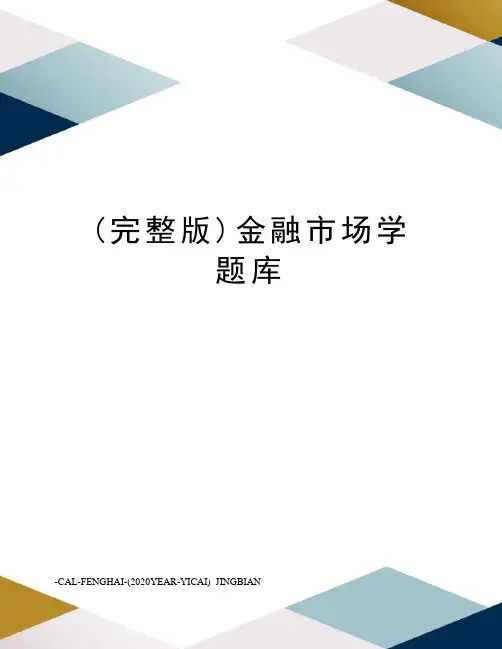
(完整版)金融市场学题库-CAL-FENGHAI-(2020YEAR-YICAI)_JINGBIAN金融市场学一、单选题1.金融市场被称为国民经济的“晴雨表”,这实际上指的就是金融市场( D )。
A.分配功能 B.财富功能 C.流动性功能 D.反映功能2.金融市场的宏观经济功能不包括( B )。
A.分配功能 B.财富功能 C.调节功能 D.反映功能3.金融市场的配置功能不表现( C )方面。
A.资源的配置 B.财富的再分配 C.信息的再分配 D.风险的再分配4.金融工具的收益有两种形式,其中下列哪项收益形式与其它几项不同( D )。
A.利息 B.股息 C.红利 D.资本利得5.一般来说,( B )不影响金融工具的安全性。
A.发行人的信用状况 B.金融工具的收益大小 C.发行人的经营状况D.金融工具本身的设计6.按( D )划分为货币市场、资本市场、外汇市场、保险市场、衍生金融市场。
A.交易范围 B.交易方式 C.定价方式 D.交易对象7.( B )是货币市场区别于其它市场的重要特征之一。
A.市场交易频繁 B.市场交易量大 C.市场交易灵活 D.市场交易对象固定8.( A )一般没有正式的组织,其交易活动不是在特定的场所中集中开展,而是通过电信网络形式完成。
A.货币市场 B.资本市场 C.外汇市场 D.保险市场三、判断题1.金融市场媒体(不管是中介机构还是经纪人)参与金融市场活动时,并非真正意义上的货币资金供给者或需求者。
(√)2.金融工具交易或买卖过程中所产生的运行机制,是金融市场的深刻内涵和自然发展,其中最核心的是供求机制。
( X )3.金融市场被称为国民经济的“晴雨表”,这实际上指的就是金融市场调节功能。
( X )4.金融中介性媒体不仅包括存款性金融机构、非存款性金融机构以及作为金融市场监管者的中央银行,而且包括金融市场经纪人。
(√)5.资本市场是指以期限在一年以内的金融工具为交易对象的短期金融市场。
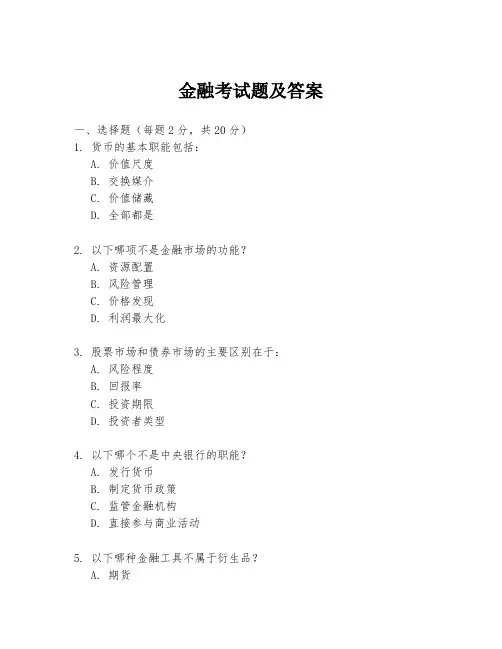
金融考试题及答案一、选择题(每题2分,共20分)1. 货币的基本职能包括:A. 价值尺度B. 交换媒介C. 价值储藏D. 全部都是2. 以下哪项不是金融市场的功能?A. 资源配置B. 风险管理C. 价格发现D. 利润最大化3. 股票市场和债券市场的主要区别在于:A. 风险程度B. 回报率C. 投资期限D. 投资者类型4. 以下哪个不是中央银行的职能?A. 发行货币B. 制定货币政策C. 监管金融机构D. 直接参与商业活动5. 以下哪种金融工具不属于衍生品?A. 期货B. 期权C. 股票D. 掉期6. 利率上升时,债券价格通常会:A. 上升B. 下降C. 不变D. 先上升后下降7. 以下哪个指标用于衡量公司偿还短期债务的能力?A. 流动比率B. 速动比率C. 资产负债率D. 股东权益比率8. 以下哪种投资策略属于主动管理?A. 指数基金B. 被动基金C. 市场时机D. 资产配置9. 金融杠杆的作用是:A. 降低风险B. 增加收益C. 放大风险D. 减少收益10. 以下哪个是现代投资组合理论的基本原则?A. 风险和收益的权衡B. 市场效率C. 风险分散化D. 所有都是答案:1-5 D,D,A,D,C; 6-10 B,A,C,C,D二、简答题(每题10分,共30分)1. 什么是货币政策?请简述其主要工具。
答:货币政策是中央银行通过调整货币供应量来影响经济活动和价格水平的政策。
主要工具包括:公开市场操作、调整存款准备金率和调整再贴现率。
2. 什么是信用风险?金融机构如何管理信用风险?答:信用风险是指借款人或对手方未能履行合同义务,导致金融机构遭受损失的风险。
管理信用风险的方法包括:信用评分、信用限额、担保和抵押、分散投资和风险转移等。
3. 什么是有效市场假说?它对投资者有何启示?答:有效市场假说认为市场价格已经反映了所有可获得的信息,因此投资者无法通过分析公开信息来获得超额收益。
对投资者的启示是:选择指数基金等被动投资策略,或者专注于非公开信息的分析。
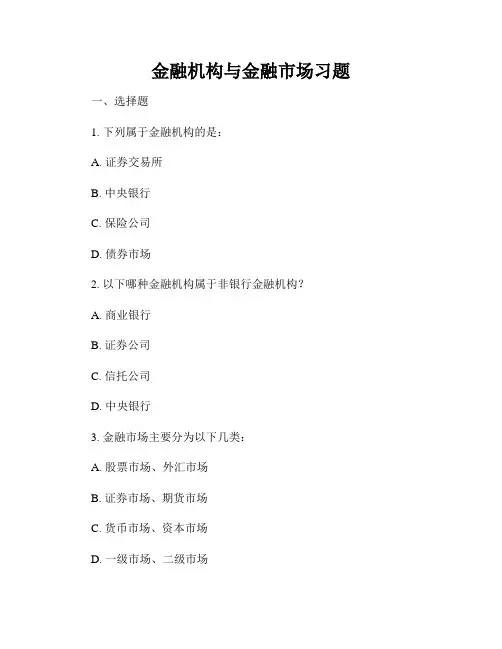
金融机构与金融市场习题一、选择题1. 下列属于金融机构的是:A. 证券交易所B. 中央银行C. 保险公司D. 债券市场2. 以下哪种金融机构属于非银行金融机构?A. 商业银行B. 证券公司C. 信托公司D. 中央银行3. 金融市场主要分为以下几类:A. 股票市场、外汇市场B. 证券市场、期货市场C. 货币市场、资本市场D. 一级市场、二级市场4. 以下属于资本市场的是:A. 银行间市场B. 股票市场C. 外汇市场D. 期货市场5. 金融市场的特点包括:A. 高流动性B. 高收益性C. 高保密性D. 高风险性二、填空题1. ________ 是中国的中央银行。
2. ________是金融机构向中央银行借款的一种方式。
3. ________是指金融机构从客户手中募集资金的一种方式。
4. ________是金融市场上流通的标准化证券。
5. ________是金融机构从金融市场上筹集资金的一种方式。
三、简答题1. 请简要介绍商业银行的功能和作用。
2. 金融市场与金融机构有何联系和区别?3. 请简述资本市场的特点和功能。
4. 信托公司和证券公司分别承担着什么样的金融服务?四、论述题金融机构在金融市场中扮演着重要的角色,请阐述金融机构的功能和意义,并举例说明金融机构在促进经济发展中的作用。
五、应用题请结合实际案例,分析金融市场对于经济发展的影响,并重点讨论金融市场的风险管理和监管问题。
六、综合题金融机构与金融市场的关系极其密切,二者相辅相成。
请综合前述题目中的知识点,阐述金融机构如何通过金融市场来实现自身的发展和服务功能,并说明金融市场如何影响金融机构的运作和业务策略。
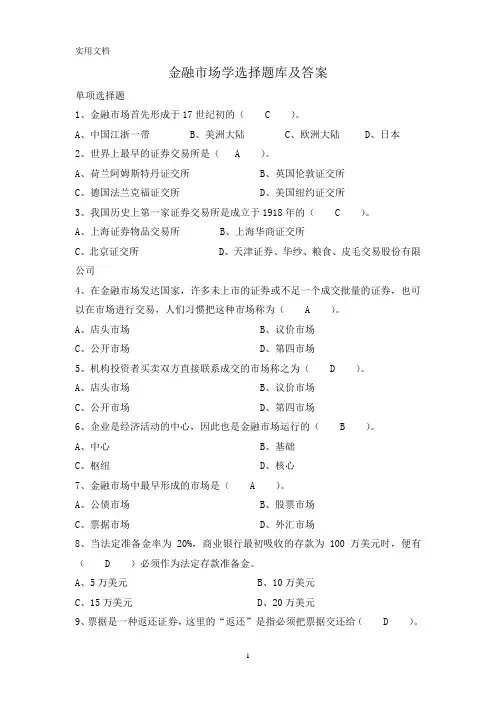
金融市场学选择题库及答案单项选择题1、金融市场首先形成于17世纪初的( C )。
A、中国江浙一带B、美洲大陆C、欧洲大陆D、日本2、世界上最早的证券交易所是( A )。
A、荷兰阿姆斯特丹证交所B、英国伦敦证交所C、德国法兰克福证交所D、美国纽约证交所3、我国历史上第一家证券交易所是成立于1918年的( C )。
A、上海证券物品交易所B、上海华商证交所C、北京证交所D、天津证券、华纱、粮食、皮毛交易股份有限公司4、在金融市场发达国家,许多未上市的证券或不足一个成交批量的证券,也可以在市场进行交易,人们习惯把这种市场称为( A )。
A、店头市场B、议价市场C、公开市场D、第四市场5、机构投资者买卖双方直接联系成交的市场称之为( D )。
A、店头市场B、议价市场C、公开市场D、第四市场6、企业是经济活动的中心,因此也是金融市场运行的( B )。
A、中心B、基础C、枢纽D、核心7、金融市场中最早形成的市场是( A )。
A、公债市场B、股票市场C、票据市场D、外汇市场8、当法定准备金率为20%,商业银行最初吸收的存款为100万美元时,便有( D )必须作为法定存款准备金。
A、5万美元B、10万美元C、15万美元D、20万美元9、票据是一种返还证券,这里的“返还”是指必须把票据交还给( D )。
A、出票人B、执票人C、收款人D、付款人10、票据是一种要式证券,这里的“要式”是指( A )。
A、必须以法定方式作成B、强调票据的重要性C、盖章人必须对票据所载文字负责D、票据的权利11、在我国,证券公司在业务上必须接受( B )的领导、管理、监督和协调。
A、国务院证券委员会B、中国证监会C、中国人民银行D、财政部和国家计划委员会12、代理发行、代购代销有价证券是( B )的主要业务。
A、商人银行B、投资银行C、证券公司D、证券交易所13、历史最悠久、规模最大的( A )为世界第一大证券交易所。
A、纽约证券交易所B、东京证券交易所C、伦敦证券交易所D、香港联合交易所14、最早实行存款准备金制度的中央银行是( B )。
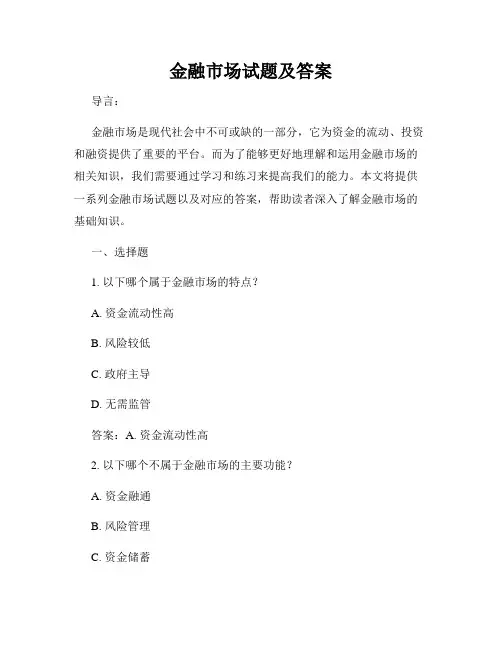
金融市场试题及答案导言:金融市场是现代社会中不可或缺的一部分,它为资金的流动、投资和融资提供了重要的平台。
而为了能够更好地理解和运用金融市场的相关知识,我们需要通过学习和练习来提高我们的能力。
本文将提供一系列金融市场试题以及对应的答案,帮助读者深入了解金融市场的基础知识。
一、选择题1. 以下哪个属于金融市场的特点?A. 资金流动性高B. 风险较低C. 政府主导D. 无需监管答案:A. 资金流动性高2. 以下哪个不属于金融市场的主要功能?A. 资金融通B. 风险管理C. 资金储蓄D. 信息披露答案:D. 信息披露3. 以下哪个市场属于金融市场?A. 商品市场B. 地产市场C. 股票市场D. 劳动力市场答案:C. 股票市场4. 金融市场中的债券是指:A. 企业的股份B. 政府的股份C. 企业的借款凭证D. 政府的借款凭证答案:C. 企业的借款凭证5. 以下哪个不属于金融市场的参与主体?A. 投资者B. 监管机构C. 企业家D. 政府机构答案:C. 企业家二、判断题1. 金融市场是指以金融资产交易为核心的场所和活动。
()答案:对2. 股票市场是指企业发行股票并在二级市场上交易的场所。
()答案:错3. 债券市场主要是为企业提供长期融资渠道。
()答案:对4. 金融市场的主要功能之一是进行风险管理。
()答案:对5. 投资者是金融市场中最重要的参与主体之一。
()答案:对三、填空题1. 金融市场的主要参与主体包括投资者、金融机构和________________。
答案:监管机构2. 股票市场上,投资者可以通过买入股票来获得股息和________________。
答案:资本收益3. 债券市场提供的主要融资工具是 __________________。
答案:债券4. 监管机构的职责之一是保护投资者的 ________________。
答案:合法权益5. 金融市场的发展与国民经济的 __________________密切相关。
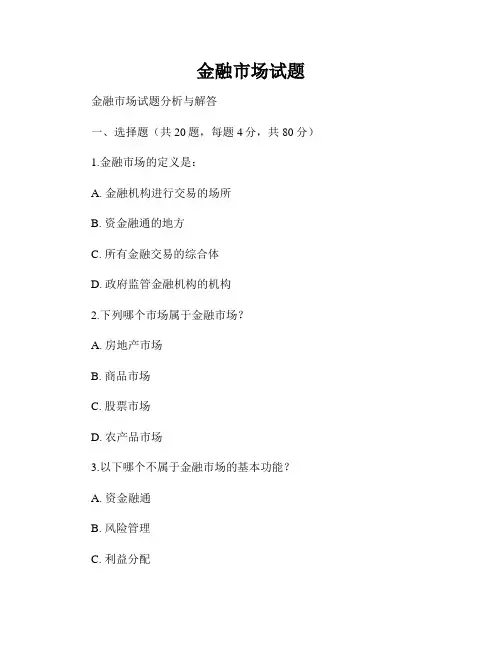
金融市场试题金融市场试题分析与解答一、选择题(共20题,每题4分,共80分)1.金融市场的定义是:A. 金融机构进行交易的场所B. 资金融通的地方C. 所有金融交易的综合体D. 政府监管金融机构的机构2.下列哪个市场属于金融市场?A. 房地产市场B. 商品市场C. 股票市场D. 农产品市场3.以下哪个不属于金融市场的基本功能?A. 资金融通B. 风险管理C. 利益分配D. 税收征管4.金融市场的分类主要可以按照以下哪种方式进行?A. 地域分类B. 符号分类C. 交易对象分类D. 利率分类5.股票市场属于以下哪种市场?A. 一级市场B. 二级市场C. 三级市场D. 道路市场6.以下哪个工具是金融市场中的衍生品?A. 股票B. 债券C. 期货D. 房地产7.金融市场中的货币市场主要包括以下哪些交易?A. 短期借款B. 股票交易C. 贷款利息支付D. 长期投资8.金融市场的主体可以分为以下哪几类?A. 金融机构B. 金融产品C. 金融中介D. 金融监管机构9.以下哪个工具可以用于金融市场的风险管理?A. 保险B. 贷款C. 储蓄D. 股票10.下列哪个不是金融市场的特点?A. 高流动性B. 高风险C. 高信用D. 高效率二、填空题(共5题,每题4分,共20分)11. ______是金融市场中的中介机构,负责向金融市场提供资金。
12. ______是金融市场中的一种交易工具,代表债务方对债权方的一种承诺。
13. ______是金融市场中的一种投资工具,代表对企业的所有权。
14. ______是金融市场中的一种风险管理工具,用于保护投资者免受资产价格波动的影响。
15. ______是金融市场中的一种交易方式,通过网络进行买卖交易。
三、问答题(每题20分,共60分)16.请简要解释金融市场的基本功能以及它们的作用。
17.金融市场的分类是如何进行的?请列举出金融市场的几种分类方法并解释它们的意义。
18.简要解释一级市场和二级市场的概念,并说明它们之间的区别。
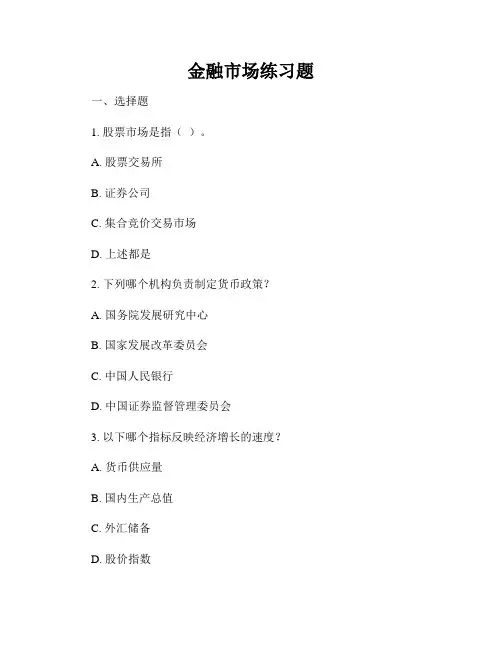
金融市场练习题一、选择题1. 股票市场是指()。
A. 股票交易所B. 证券公司C. 集合竞价交易市场D. 上述都是2. 下列哪个机构负责制定货币政策?A. 国务院发展研究中心B. 国家发展改革委员会C. 中国人民银行D. 中国证券监督管理委员会3. 以下哪个指标反映经济增长的速度?A. 货币供应量B. 国内生产总值C. 外汇储备D. 股价指数4. GDP(国内生产总值)包括下列哪些部分?A. 消费B. 投资C. 净出口D. 所有选项都对5. 股票市场中,买方报价最高的订单称为()。
A. 买一价B. 买方报价C. 买价D. 买单二、判断题1. 股票市场属于债券市场。
()2. 股票指数是对市场整体情况进行测量的指标。
()3. 外汇市场是指各国货币相互交换的市场。
()4. 黄金属于金融市场中的实物资产。
()5. 货币政策主要由央行负责制定和实施。
()三、问答题1. 请简要解释什么是利率?利率是指借贷资金的价格,也是对资金的使用成本的一种衡量。
利率的高低受到多种因素的影响,包括市场供需关系、经济政策以及预期通胀等。
2. 金融市场的主要功能有哪些?金融市场的主要功能包括为投资者提供融资渠道、为投资者提供风险管理工具、为资金提供流动性以及为资源配置提供参考等。
3. 请解释一下股票交易所的作用。
股票交易所是股票市场的机构组织,其主要作用包括提供公平公正的股票交易环境、监管市场交易行为、确保交易的有效性以及提供信息披露等服务。
四、简答题1. 请列举几种金融市场的主要参与者。
金融市场的主要参与者包括个人投资者、机构投资者、企业和政府等。
个人投资者是直接参与金融市场的个体,机构投资者包括证券公司、基金公司等专业机构。
2. 请解释一下股票价格的形成机制。
股票价格的形成机制主要受到市场供需关系的影响。
当买方愿意以高价购买股票而卖方愿意以低价出售股票时,互动的交易将推动股票价格上涨。
相反,如果卖方愿意以较高价格出售股票而买方愿意以较低价格购买股票,股票价格则可能下跌。
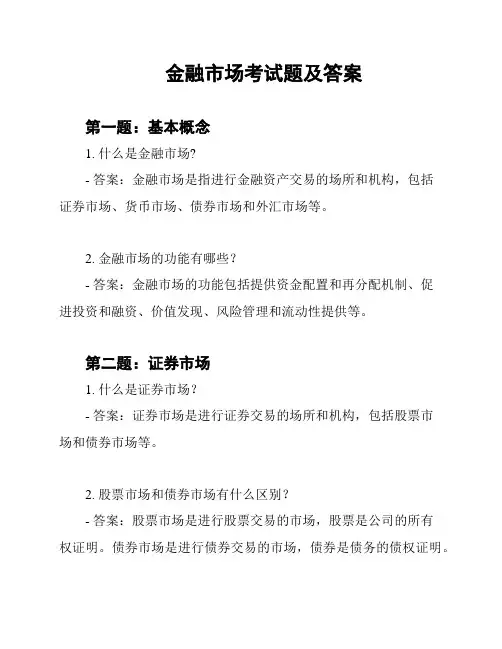
金融市场考试题及答案
第一题:基本概念
1. 什么是金融市场?
- 答案:金融市场是指进行金融资产交易的场所和机构,包括
证券市场、货币市场、债券市场和外汇市场等。
2. 金融市场的功能有哪些?
- 答案:金融市场的功能包括提供资金配置和再分配机制、促
进投资和融资、价值发现、风险管理和流动性提供等。
第二题:证券市场
1. 什么是证券市场?
- 答案:证券市场是进行证券交易的场所和机构,包括股票市
场和债券市场等。
2. 股票市场和债券市场有什么区别?
- 答案:股票市场是进行股票交易的市场,股票是公司的所有
权证明。
债券市场是进行债券交易的市场,债券是债务的债权证明。
第三题:货币市场
1. 什么是货币市场?
- 答案:货币市场是进行短期借贷和资金融通的市场,包括银
行间市场和票据市场等。
2. 货币市场的特点是什么?
- 答案:货币市场的特点包括短期性、低风险、高流动性和低
利率等。
第四题:外汇市场
1. 什么是外汇市场?
- 答案:外汇市场是进行外汇交易的市场,外汇是指不同货币
之间的兑换关系。
2. 外汇市场的参与者有哪些?
- 答案:外汇市场的参与者包括银行、企业、投资者和政府等。
第五题:金融市场监管
1. 什么是金融市场监管?
- 答案:金融市场监管是指由政府或监管机构对金融市场和金融机构进行监督和管理的活动。
2. 金融市场监管的目的是什么?
- 答案:金融市场监管的目的是维护市场秩序、保护投资者权益、防范金融风险和促进市场发展等。
以上为金融市场考试题及答案,供参考。
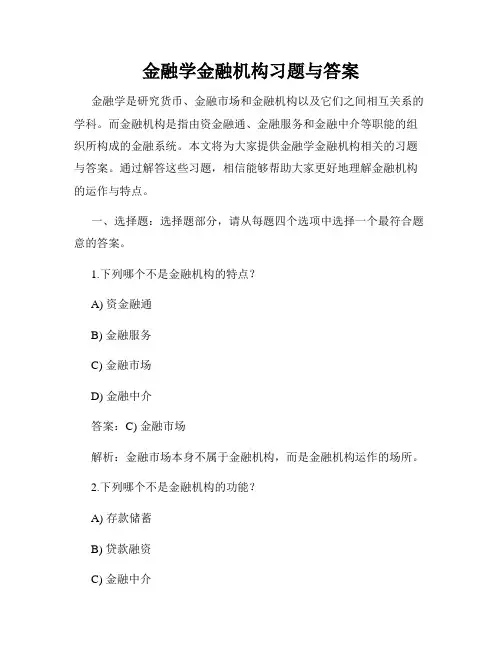
金融学金融机构习题与答案金融学是研究货币、金融市场和金融机构以及它们之间相互关系的学科。
而金融机构是指由资金融通、金融服务和金融中介等职能的组织所构成的金融系统。
本文将为大家提供金融学金融机构相关的习题与答案。
通过解答这些习题,相信能够帮助大家更好地理解金融机构的运作与特点。
一、选择题:选择题部分,请从每题四个选项中选择一个最符合题意的答案。
1.下列哪个不是金融机构的特点?A) 资金融通B) 金融服务C) 金融市场D) 金融中介答案:C) 金融市场解析:金融市场本身不属于金融机构,而是金融机构运作的场所。
2.下列哪个不是金融机构的功能?A) 存款储蓄B) 贷款融资C) 金融中介D) 汇率调控答案:D) 汇率调控解析:汇率调控属于货币政策的范畴,并非金融机构的职能。
3.下列哪个属于非银行金融机构?A) 商业银行B) 证券公司C) 农村信用社D) 央行答案:B) 证券公司解析:证券公司是一种非银行金融机构,主要从事证券经纪、承销与受托管理等业务。
4.下面哪个属于中央银行职能?A) 存款储蓄B) 贷款融资C) 储备汇款D) 股票交易答案:C) 储备汇款解析:中央银行主要负责储备外汇、管理货币政策以及维护金融稳定等职能。
二、简答题:简答题部分,请简要回答以下问题。
1. 请简述金融机构的资金融通功能。
答案:金融机构的资金融通功能是指通过接受存款和发放贷款等方式,将资金从资金供给方转移至需求方的过程。
金融机构作为金融市场与金融服务的中介,能够将大量资金汇集起来,并将其投放至需要融资的个人、企业和政府等机构。
通过资金融通,金融机构实现了资金的流动和配置,促进了经济发展。
2. 请简述商业银行的角色与职能。
答案:商业银行是金融机构中最具规模和代表性的机构之一。
其角色与职能主要包括:接受存款和储蓄,提供贷款和信贷融资服务;开展支付结算业务,维护金融系统的稳定;从事国际结算,促进国际贸易与投资;开展金融中介业务,提供金融产品与金融咨询;参与金融市场交易,提供金融产品的发行与承销等。
1. 金融市场的主要功能是什么?A. 提供资金B. 风险管理C. 价格发现D. 以上都是2. 下列哪项不是货币市场的特征?A. 短期交易B. 高流动性C. 低风险D. 高收益3. 股票市场属于哪种类型的金融市场?A. 货币市场B. 资本市场C. 衍生品市场D. 外汇市场4. 下列哪项是金融衍生品的定义?A. 一种基于基础金融资产的金融工具B. 一种长期投资工具C. 一种货币兑换工具D. 一种实物资产5. 银行间市场的主要参与者是谁?A. 个人投资者B. 商业银行C. 非银行金融机构D. 政府机构6. 下列哪项是中央银行的主要职能?A. 提供贷款B. 管理货币供应C. 提供投资咨询D. 进行股票交易7. 货币政策的主要工具包括哪些?A. 利率调整B. 公开市场操作C. 存款准备金率调整D. 以上都是8. 下列哪项是金融风险管理的主要目标?A. 增加收益B. 减少损失C. 提高流动性D. 增加市场份额9. 信用风险主要涉及哪类金融活动?A. 贷款B. 投资C. 保险D. 外汇交易10. 市场风险主要由什么因素引起?A. 利率变动B. 汇率变动C. 股票价格变动D. 以上都是11. 下列哪项是金融监管的主要目的?A. 保护消费者B. 维护市场稳定C. 促进金融创新D. 以上都是12. 金融市场的效率主要体现在哪些方面?A. 信息效率B. 交易效率C. 分配效率D. 以上都是13. 下列哪项是金融市场的主要参与者?A. 个人投资者B. 机构投资者C. 政府机构D. 以上都是14. 金融市场的国际化主要体现在哪些方面?A. 跨国投资B. 国际金融产品C. 国际金融监管D. 以上都是15. 下列哪项是金融市场的主要风险?A. 信用风险B. 市场风险C. 操作风险D. 以上都是16. 金融市场的流动性主要由什么决定?A. 市场参与者的数量B. 交易工具的种类C. 市场规则D. 以上都是17. 下列哪项是金融市场的主要功能?A. 资金筹集B. 风险分散C. 资源配置D. 以上都是18. 金融市场的价格发现功能主要体现在哪些方面?A. 股票价格B. 债券价格C. 外汇价格D. 以上都是19. 下列哪项是金融市场的主要特征?A. 高流动性B. 高风险C. 高收益D. 以上都是20. 金融市场的主要参与者包括哪些?A. 个人投资者B. 机构投资者C. 政府机构D. 以上都是21. 金融市场的主要风险包括哪些?A. 信用风险B. 市场风险C. 操作风险D. 以上都是22. 金融市场的主要功能包括哪些?A. 资金筹集B. 风险分散C. 资源配置D. 以上都是23. 金融市场的主要特征包括哪些?A. 高流动性B. 高风险C. 高收益D. 以上都是24. 金融市场的主要参与者包括哪些?A. 个人投资者B. 机构投资者C. 政府机构D. 以上都是25. 金融市场的主要风险包括哪些?A. 信用风险B. 市场风险C. 操作风险D. 以上都是26. 金融市场的主要功能包括哪些?A. 资金筹集B. 风险分散C. 资源配置D. 以上都是27. 金融市场的主要特征包括哪些?A. 高流动性B. 高风险C. 高收益D. 以上都是28. 金融市场的主要参与者包括哪些?A. 个人投资者B. 机构投资者C. 政府机构D. 以上都是29. 金融市场的主要风险包括哪些?A. 信用风险B. 市场风险C. 操作风险D. 以上都是30. 金融市场的主要功能包括哪些?A. 资金筹集B. 风险分散C. 资源配置D. 以上都是31. 金融市场的主要特征包括哪些?A. 高流动性B. 高风险C. 高收益D. 以上都是32. 金融市场的主要参与者包括哪些?A. 个人投资者B. 机构投资者C. 政府机构D. 以上都是33. 金融市场的主要风险包括哪些?A. 信用风险B. 市场风险C. 操作风险D. 以上都是34. 金融市场的主要功能包括哪些?A. 资金筹集B. 风险分散C. 资源配置D. 以上都是35. 金融市场的主要特征包括哪些?A. 高流动性B. 高风险C. 高收益D. 以上都是36. 金融市场的主要参与者包括哪些?A. 个人投资者B. 机构投资者C. 政府机构D. 以上都是37. 金融市场的主要风险包括哪些?A. 信用风险B. 市场风险C. 操作风险D. 以上都是38. 金融市场的主要功能包括哪些?A. 资金筹集B. 风险分散C. 资源配置D. 以上都是39. 金融市场的主要特征包括哪些?A. 高流动性B. 高风险C. 高收益D. 以上都是40. 金融市场的主要参与者包括哪些?A. 个人投资者B. 机构投资者C. 政府机构D. 以上都是41. 金融市场的主要风险包括哪些?A. 信用风险B. 市场风险C. 操作风险D. 以上都是42. 金融市场的主要功能包括哪些?A. 资金筹集B. 风险分散C. 资源配置D. 以上都是43. 金融市场的主要特征包括哪些?A. 高流动性B. 高风险C. 高收益D. 以上都是44. 金融市场的主要参与者包括哪些?A. 个人投资者B. 机构投资者C. 政府机构D. 以上都是45. 金融市场的主要风险包括哪些?A. 信用风险B. 市场风险C. 操作风险D. 以上都是46. 金融市场的主要功能包括哪些?A. 资金筹集B. 风险分散C. 资源配置D. 以上都是47. 金融市场的主要特征包括哪些?A. 高流动性B. 高风险C. 高收益D. 以上都是48. 金融市场的主要参与者包括哪些?A. 个人投资者B. 机构投资者C. 政府机构D. 以上都是49. 金融市场的主要风险包括哪些?A. 信用风险B. 市场风险C. 操作风险D. 以上都是50. 金融市场的主要功能包括哪些?A. 资金筹集B. 风险分散C. 资源配置D. 以上都是51. 金融市场的主要特征包括哪些?A. 高流动性B. 高风险C. 高收益D. 以上都是52. 金融市场的主要参与者包括哪些?A. 个人投资者B. 机构投资者C. 政府机构D. 以上都是53. 金融市场的主要风险包括哪些?A. 信用风险B. 市场风险C. 操作风险D. 以上都是54. 金融市场的主要功能包括哪些?A. 资金筹集B. 风险分散C. 资源配置D. 以上都是55. 金融市场的主要特征包括哪些?A. 高流动性B. 高风险C. 高收益D. 以上都是56. 金融市场的主要参与者包括哪些?A. 个人投资者B. 机构投资者C. 政府机构D. 以上都是57. 金融市场的主要风险包括哪些?A. 信用风险B. 市场风险C. 操作风险D. 以上都是58. 金融市场的主要功能包括哪些?A. 资金筹集B. 风险分散C. 资源配置D. 以上都是59. 金融市场的主要特征包括哪些?A. 高流动性B. 高风险C. 高收益D. 以上都是60. 金融市场的主要参与者包括哪些?A. 个人投资者B. 机构投资者C. 政府机构D. 以上都是61. 金融市场的主要风险包括哪些?A. 信用风险B. 市场风险C. 操作风险D. 以上都是62. 金融市场的主要功能包括哪些?A. 资金筹集B. 风险分散C. 资源配置D. 以上都是63. 金融市场的主要特征包括哪些?A. 高流动性B. 高风险C. 高收益D. 以上都是64. 金融市场的主要参与者包括哪些?A. 个人投资者B. 机构投资者C. 政府机构D. 以上都是答案:1. D2. D3. B4. A5. B6. B7. D8. B9. A10. D11. D12. D13. D14. D15. D16. D17. D18. D19. D20. D21. D22. D23. D24. D25. D26. D27. D28. D29. D30. D31. D32. D33. D34. D35. D36. D37. D38. D39. D40. D41. D42. D43. D44. D45. D46. D47. D48. D49. D50. D51. D52. D53. D54. D55. D56. D57. D58. D59. D60. D61. D62. D63. D64. D。
金融市场与机构考试试题一、选择题1. 以下哪个不是金融市场的特点?A. 资金融通的功能B. 价格发现的功能C. 风险管理的功能D. 各种产品的交易场所2. 下列哪个机构不属于金融机构?A. 商业银行B. 证券公司C. 保险公司D. 制造企业3. 以下哪个机构不属于金融市场的组成部分?A. 证券交易所B. 信用评级机构C. 金融监管部门D. 交易商行会4. 以下哪个不是金融市场的分类?A. 股票市场B. 期货市场C. 债券市场D. 人才市场5. 以下哪个不是金融机构的特点?A. 实行存、贷、汇、结合的业务B. 提供金融中介服务C. 承担风险和收益的转移D. 进行收付款、结算业务二、判断题1. 金融市场是实现闲置资金与资金需求者之间的资金融通的场所。
(√)2. 证券公司在金融市场中扮演了资金供给者的角色。
(×)3. 商业银行是金融市场的重要参与者之一。
(√)4. 金融机构主要提供金融服务,而非实际商品或服务。
(√)5. 金融市场的分类依据主要是交易品种的不同。
(√)三、简答题1. 请简要介绍金融市场的主要功能。
金融市场的主要功能包括资金融通的功能、价格发现的功能、风险管理的功能和资源配置的功能。
首先,资金融通的功能指的是金融市场通过将闲置资金与资金需求者相互匹配,实现资金的流动和配置。
金融市场提供了一个集中交易的场所,使得资金能够迅速从资金供给者流向资金需求者,促进了经济的发展和资源的高效利用。
其次,价格发现的功能是金融市场通过交易活动,使得各种金融资产的价格能够得到公开透明地确定。
市场上的供求关系决定了金融资产的价格水平,市场上的交易活动会不断调整价格,反映市场对资产价值的认知和预期。
第三,风险管理的功能是金融市场通过提供各种金融衍生品和风险管理工具,帮助市场参与者进行风险的保护和管理。
金融市场中的交易活动可以帮助投资者实现风险的分散和转移,降低个体风险对整体经济的影响。
最后,金融市场还具有资源配置的功能。
1. 金融市场的主要功能是:A. 提供融资渠道B. 风险管理C. 价格发现D. 以上都是2. 下列哪项不是金融市场的参与者?A. 个人投资者B. 中央银行C. 零售商D. 投资银行3. 股票市场的主要功能是:A. 公司融资B. 股票交易C. 股东权益保护D. 以上都是4. 债券市场的主要功能是:A. 政府融资B. 企业融资C. 固定收益投资D. 以上都是5. 下列哪项不是货币市场的特征?A. 短期融资B. 高流动性C. 低风险D. 高收益6. 下列哪项不是资本市场的特征?A. 长期融资B. 低流动性C. 高风险D. 高收益7. 下列哪项不是金融衍生品的特点?A. 杠杆交易B. 风险转移C. 实物交割D. 价格发现8. 期权合约的买方有权:A. 买入或卖出标的资产B. 仅买入标的资产C. 仅卖出标的资产D. 无权交易9. 期货合约的特征包括:A. 标准化合约B. 杠杆交易C. 每日结算D. 以上都是10. 下列哪项不是投资组合管理的目标?A. 风险最小化B. 收益最大化C. 流动性最大化D. 分散化11. 资本资产定价模型(CAPM)的主要假设是:A. 市场无摩擦B. 投资者风险厌恶C. 单一投资期限D. 以上都是12. 下列哪项不是有效市场假说(EMH)的类型?A. 弱式有效市场B. 半强式有效市场C. 强式有效市场D. 超强式有效市场13. 下列哪项不是技术分析的假设?A. 历史会重演B. 市场行为涵盖一切信息C. 价格随机游走D. 趋势存在14. 下列哪项不是基本面分析的工具?A. 财务报表分析B. 宏观经济分析C. 图表分析D. 行业分析15. 下列哪项不是投资风险?A. 市场风险B. 信用风险C. 流动性风险D. 收益风险16. 下列哪项不是投资策略?A. 价值投资B. 成长投资C. 随机投资D. 指数投资17. 下列哪项不是投资工具?A. 股票B. 债券C. 房地产D. 人力资源18. 下列哪项不是投资分析的方法?A. 定量分析B. 定性分析C. 混合分析D. 随机分析19. 下列哪项不是投资组合的优化方法?A. 均值-方差模型B. 资本资产定价模型C. 随机优化模型D. 风险平价模型20. 下列哪项不是投资绩效评估的指标?A. 夏普比率B. 特雷诺比率C. 詹森指数D. 随机指数21. 下列哪项不是投资决策的影响因素?A. 投资者风险偏好B. 市场预期C. 政治因素D. 随机因素22. 下列哪项不是投资组合的分散化好处?A. 降低风险B. 提高收益C. 增加流动性D. 提高多样化23. 下列哪项不是投资组合的风险类型?A. 系统性风险B. 非系统性风险C. 随机风险D. 市场风险24. 下列哪项不是投资组合的收益来源?A. 资本增值B. 股息收入C. 利息收入D. 随机收入25. 下列哪项不是投资组合的调整原因?A. 市场变化B. 投资者目标变化C. 随机事件D. 投资工具变化26. 下列哪项不是投资组合的调整方法?A. 增加新资产B. 减少现有资产C. 随机调整D. 资产重组27. 下列哪项不是投资组合的调整策略?A. 主动管理B. 被动管理C. 随机管理D. 混合管理28. 下列哪项不是投资组合的调整时机?A. 市场波动B. 投资者需求变化C. 随机事件D. 投资周期结束29. 下列哪项不是投资组合的调整目标?A. 风险控制B. 收益优化C. 随机目标D. 流动性管理30. 下列哪项不是投资组合的调整工具?A. 股票B. 债券C. 随机工具D. 衍生品31. 下列哪项不是投资组合的调整原则?A. 风险收益平衡B. 多样化C. 随机原则D. 流动性管理32. 下列哪项不是投资组合的调整方法?A. 增加新资产B. 减少现有资产C. 随机调整D. 资产重组33. 下列哪项不是投资组合的调整策略?A. 主动管理B. 被动管理C. 随机管理D. 混合管理34. 下列哪项不是投资组合的调整时机?A. 市场波动B. 投资者需求变化C. 随机事件D. 投资周期结束35. 下列哪项不是投资组合的调整目标?A. 风险控制B. 收益优化C. 随机目标D. 流动性管理36. 下列哪项不是投资组合的调整工具?A. 股票B. 债券C. 随机工具D. 衍生品37. 下列哪项不是投资组合的调整原则?A. 风险收益平衡B. 多样化C. 随机原则D. 流动性管理38. 下列哪项不是投资组合的调整方法?A. 增加新资产B. 减少现有资产C. 随机调整D. 资产重组39. 下列哪项不是投资组合的调整策略?A. 主动管理B. 被动管理C. 随机管理D. 混合管理40. 下列哪项不是投资组合的调整时机?A. 市场波动B. 投资者需求变化C. 随机事件D. 投资周期结束41. 下列哪项不是投资组合的调整目标?A. 风险控制B. 收益优化C. 随机目标D. 流动性管理42. 下列哪项不是投资组合的调整工具?A. 股票B. 债券C. 随机工具D. 衍生品43. 下列哪项不是投资组合的调整原则?A. 风险收益平衡B. 多样化C. 随机原则D. 流动性管理44. 下列哪项不是投资组合的调整方法?A. 增加新资产B. 减少现有资产C. 随机调整D. 资产重组45. 下列哪项不是投资组合的调整策略?A. 主动管理B. 被动管理C. 随机管理D. 混合管理46. 下列哪项不是投资组合的调整时机?A. 市场波动B. 投资者需求变化C. 随机事件D. 投资周期结束47. 下列哪项不是投资组合的调整目标?A. 风险控制B. 收益优化C. 随机目标D. 流动性管理48. 下列哪项不是投资组合的调整工具?A. 股票B. 债券C. 随机工具D. 衍生品49. 下列哪项不是投资组合的调整原则?A. 风险收益平衡B. 多样化C. 随机原则D. 流动性管理50. 下列哪项不是投资组合的调整方法?A. 增加新资产B. 减少现有资产C. 随机调整D. 资产重组51. 下列哪项不是投资组合的调整策略?A. 主动管理B. 被动管理C. 随机管理D. 混合管理52. 下列哪项不是投资组合的调整时机?A. 市场波动B. 投资者需求变化C. 随机事件D. 投资周期结束53. 下列哪项不是投资组合的调整目标?A. 风险控制B. 收益优化C. 随机目标D. 流动性管理54. 下列哪项不是投资组合的调整工具?A. 股票B. 债券C. 随机工具D. 衍生品答案:1. D2. C3. D4. D5. D6. D7. C8. A9. D10. C11. D12. D13. C14. C15. D16. C17. D18. D19. C20. D21. D22. B23. C24. D25. C26. C27. C28. C29. C30. C31. C32. C33. C34. C35. C36. C37. C38. C39. C40. C41. C42. C43. C44. C45. C46. C47. C48. C49. C50. C51. C52. C53. C54. C。
1. 金融市场的主要功能是:A. 提供融资渠道B. 提供投资机会C. 提供风险管理工具D. 以上都是2. 下列哪项不是资本市场的特点?A. 长期投资B. 高风险C. 短期融资D. 高回报潜力3. 股票市场属于:A. 货币市场B. 资本市场C. 衍生品市场D. 外汇市场4. 债券的本质是:A. 股权B. 债务C. 期权D. 期货5. 下列哪项不是投资银行的主要业务?A. 证券承销B. 资产管理C. 零售银行业务D. 企业并购咨询6. 风险管理的主要目的是:A. 消除风险B. 转移风险C. 识别和控制风险D. 增加风险7. 下列哪项不是金融衍生品?A. 期货合约B. 期权C. 股票D. 互换合约8. 货币政策的主要工具包括:A. 利率调整B. 公开市场操作C. 存款准备金率调整D. 以上都是9. 下列哪项不是商业银行的主要业务?A. 存款业务B. 贷款业务C. 证券承销D. 支付结算10. 资本充足率是衡量银行:A. 资产质量B. 盈利能力C. 流动性D. 风险承受能力11. 下列哪项不是金融监管的主要目标?A. 保护投资者B. 维护市场秩序C. 促进经济增长D. 增加税收12. 下列哪项不是金融市场的参与者?A. 个人投资者B. 企业C. 政府D. 非营利组织13. 下列哪项不是金融市场的分类?A. 股票市场B. 债券市场C. 商品市场D. 外汇市场14. 下列哪项不是金融市场的功能?A. 价格发现B. 流动性提供C. 风险转移D. 产品创新15. 下列哪项不是金融市场的特点?A. 高流动性B. 低风险C. 高波动性D. 高回报潜力16. 下列哪项不是金融市场的参与者?A. 个人投资者B. 企业C. 政府D. 非营利组织17. 下列哪项不是金融市场的分类?A. 股票市场B. 债券市场C. 商品市场D. 外汇市场18. 下列哪项不是金融市场的功能?A. 价格发现B. 流动性提供C. 风险转移D. 产品创新19. 下列哪项不是金融市场的特点?A. 高流动性B. 低风险C. 高波动性D. 高回报潜力20. 下列哪项不是金融市场的参与者?A. 个人投资者B. 企业C. 政府D. 非营利组织21. 下列哪项不是金融市场的分类?A. 股票市场B. 债券市场C. 商品市场D. 外汇市场22. 下列哪项不是金融市场的功能?A. 价格发现B. 流动性提供C. 风险转移D. 产品创新23. 下列哪项不是金融市场的特点?A. 高流动性B. 低风险C. 高波动性D. 高回报潜力24. 下列哪项不是金融市场的参与者?A. 个人投资者B. 企业C. 政府D. 非营利组织25. 下列哪项不是金融市场的分类?A. 股票市场B. 债券市场C. 商品市场D. 外汇市场26. 下列哪项不是金融市场的功能?A. 价格发现B. 流动性提供C. 风险转移D. 产品创新27. 下列哪项不是金融市场的特点?A. 高流动性B. 低风险C. 高波动性D. 高回报潜力28. 下列哪项不是金融市场的参与者?A. 个人投资者B. 企业C. 政府D. 非营利组织29. 下列哪项不是金融市场的分类?A. 股票市场B. 债券市场C. 商品市场D. 外汇市场30. 下列哪项不是金融市场的功能?A. 价格发现B. 流动性提供C. 风险转移D. 产品创新31. 下列哪项不是金融市场的特点?A. 高流动性B. 低风险C. 高波动性D. 高回报潜力32. 下列哪项不是金融市场的参与者?A. 个人投资者B. 企业C. 政府D. 非营利组织33. 下列哪项不是金融市场的分类?A. 股票市场B. 债券市场C. 商品市场D. 外汇市场34. 下列哪项不是金融市场的功能?A. 价格发现B. 流动性提供C. 风险转移D. 产品创新35. 下列哪项不是金融市场的特点?A. 高流动性B. 低风险C. 高波动性D. 高回报潜力36. 下列哪项不是金融市场的参与者?A. 个人投资者B. 企业C. 政府D. 非营利组织37. 下列哪项不是金融市场的分类?A. 股票市场B. 债券市场C. 商品市场D. 外汇市场38. 下列哪项不是金融市场的功能?A. 价格发现B. 流动性提供C. 风险转移D. 产品创新39. 下列哪项不是金融市场的特点?A. 高流动性B. 低风险C. 高波动性D. 高回报潜力40. 下列哪项不是金融市场的参与者?A. 个人投资者B. 企业C. 政府D. 非营利组织41. 下列哪项不是金融市场的分类?A. 股票市场B. 债券市场C. 商品市场D. 外汇市场42. 下列哪项不是金融市场的功能?A. 价格发现B. 流动性提供C. 风险转移D. 产品创新43. 下列哪项不是金融市场的特点?A. 高流动性B. 低风险C. 高波动性D. 高回报潜力44. 下列哪项不是金融市场的参与者?A. 个人投资者B. 企业C. 政府D. 非营利组织45. 下列哪项不是金融市场的分类?A. 股票市场B. 债券市场C. 商品市场D. 外汇市场46. 下列哪项不是金融市场的功能?A. 价格发现B. 流动性提供C. 风险转移D. 产品创新47. 下列哪项不是金融市场的特点?A. 高流动性B. 低风险C. 高波动性D. 高回报潜力48. 下列哪项不是金融市场的参与者?A. 个人投资者B. 企业C. 政府D. 非营利组织49. 下列哪项不是金融市场的分类?A. 股票市场B. 债券市场C. 商品市场D. 外汇市场50. 下列哪项不是金融市场的功能?A. 价格发现B. 流动性提供C. 风险转移D. 产品创新51. 下列哪项不是金融市场的特点?A. 高流动性B. 低风险C. 高波动性D. 高回报潜力52. 下列哪项不是金融市场的参与者?A. 个人投资者B. 企业C. 政府D. 非营利组织53. 下列哪项不是金融市场的分类?A. 股票市场B. 债券市场C. 商品市场D. 外汇市场54. 下列哪项不是金融市场的功能?A. 价格发现B. 流动性提供C. 风险转移D. 产品创新55. 下列哪项不是金融市场的特点?A. 高流动性B. 低风险C. 高波动性D. 高回报潜力56. 下列哪项不是金融市场的参与者?A. 个人投资者B. 企业C. 政府D. 非营利组织57. 下列哪项不是金融市场的分类?A. 股票市场B. 债券市场C. 商品市场D. 外汇市场58. 下列哪项不是金融市场的功能?A. 价格发现B. 流动性提供C. 风险转移D. 产品创新59. 下列哪项不是金融市场的特点?A. 高流动性B. 低风险C. 高波动性D. 高回报潜力答案:1. D2. C3. B4. B5. C6. C8. D9. C10. D11. D12. D13. C14. D15. B16. D17. C18. D19. B20. D21. C22. D23. B24. D25. C26. D27. B28. D29. C30. D31. B32. D33. C34. D35. B36. D37. C38. D39. B40. D41. C42. D43. B44. D45. C46. D47. B48. D49. C50. D51. B52. D53. C54. D55. B56. D58. D59. B。
金融市场与金融机构试题库
一、单项选择题(本大题共40小题,每小题1分,共40分)
1. 二战前,世界上最大的黄金市场是( )
A.苏黎世黄金市场
B.香港黄金市场
C.纽约黄金市场
D.伦敦黄金市场
2. 以下不属于证券交易所的职责的是( )
A.提供交易场所和设施
B.制定交易规则
C.制定交易价格
D.公布行情
3. 政府债券的风险主要变现为( )
A.信用风险
B.财务风险
C.经营风险
D.购买力风险
4. 贴现债券的实际收益率与票面利率相比( )
A.高
B.相等
C.低
D.不确定
5. 我国证券交易所的组织形式是( )
A.公司制
B.股份制
C.会员制
D.席位制
6. 下列市场中属于资本市场的有( )
A.股票市场
B.短期国库券市场
C.银行承兑汇票市场
D.大额可转让定期存单市场
7. 以下( )发行方式,承销商要承担全部发行失败的风险。
A.代销
B.余额包销
C.全额包销
D.中央银行包销
8. 投机性货币需求与利率水平之间呈( )
A.正相关
B.负相关
C.不相关
D.相关的不确定性
9. 股票在证券交易所挂牌买卖,称为( )
A.场内交易
B.场外交易
C.柜台交易
D.议价市场
10. 商业银行向中央银行所作的票据转让行为叫( )
A.贴现
B.承兑
C.转贴现
D.再贴现。
《金融市场与金融机构》题集一、选择题(每题2分,共20分)1.下列哪一项不属于金融市场的功能?A. 资源配置B. 风险分散C. 价格发现D. 商品交易2.下列哪一项是货币市场的特点?A. 长期性B. 高风险性C. 高流动性D. 低流动性3.下列哪一项不是金融机构的主要功能?A. 资金中介B. 支付中介C. 信息服务D. 商品生产4.下列哪一项属于资本市场的工具?A. 国库券B. 商业票据C. 股票D. 银行定期存款5.下列哪一项是中央银行的主要职能?A. 吸收公众存款B. 发行货币C. 提供商业贷款D. 经营保险业务6.下列哪一项不是商业银行的业务?A. 吸收存款B. 发放贷款C. 办理结算D. 发行股票7.下列哪一项属于金融衍生品?A. 债券B. 股票C. 期货D. 存款8.下列哪一项是证券市场的特点?A. 交易对象固定B. 交易价格不固定C. 交易场所不固定D. 交易时间不固定9.下列哪一项是投资银行的主要业务?A. 吸收公众存款B. 发放贷款C. 证券承销与交易D. 办理保险10.下列哪一项不是金融市场的构成要素?A. 市场主体B. 市场客体C. 市场价格D. 市场环境二、填空题(每空2分,共20分)1.金融市场按照交易工具的期限可以分为______和______。
2.金融机构体系一般由______、______和其他金融机构组成。
3.中央银行的主要职能包括______、______和维护金融稳定。
4.资本市场的工具主要包括______和______。
5.金融衍生品市场包括______市场和______市场。
三、判断题(每题2分,共10分)1.金融市场是指资金供求双方进行资金融通和有价证券交易的市场。
()2.货币市场是短期金融工具交易的市场,其交易工具的期限通常在一年以上。
()3.商业银行是以盈利为目的,以多种金融负债筹集资金,多种金融资产为经营对象,具有信用创造功能的金融机构。
()4.证券市场是股票、债券等有价证券发行和交易的场所,是资本市场的核心。
Chapter 2 Overview2.1Function of Financial Markets1. Financial markets have the basic function ofA) Getting people with funds to lend together with people who want to borrow funds.B) assuring that the swings in the business cycle are less pronounced.C) assuring that governments need never resort to printing money.D) providing a risk-free repository of spending power.Answer: A2. Which of the following can be described as direct finance?A) You take out a mortgage from your local bank.B) You borrow $2500 from a friend.C) You buy shares of common stock in the secondary market.D) You buy shares in a mutual fund.Answer: B3. Which of the following can be described as involving indirect finance?A) You make a loan to your neighbor.B) You buy shares in a mutual fund.C) You buy a U.S. Treasury bill from the U.S. Treasury.D) A corporation buys a short-term security issued by another corporation in the primary market.Answer: B4. You can borrow $5000 to finance a new business venture. This new venture will generate annual earnings of $251. The maximum interest rate that you would pay on the borrowed funds and still increase your income isA) 25%.B) 12.5%.C) 10%.D) 5%.Answer: D5. With ________ finance, borrowers obtain funds from lenders by selling them securities in the financial markets.A) activeB) determinedC) indirectD) directAnswer: D2.2 Structure of Financial Markets6. Which of the following statements about the characteristics of debt and equities is true?A) They can both be long-term financial instruments.B) Bond holders are residual claimants.C) The income from bonds is typically more variable than that from equities.D) Bonds pay dividends.Answer: A7. Forty or so dealers establish a "market" in these securities by standing ready to buy and sell them.A) Secondary stocksB) Surplus stocksC) U.S. government bondsD) Common stocksAnswer: C8. Secondary markets make financial instruments moreA) solid.B) vapid.C) liquid.D) risky.Answer: C9. An important financial institution that assists in the initial sale of securities in the primary market is theA) investment bank.B) commercial bank.C) stock exchange.D) brokerage house.Answer: A10. A corporation acquires new funds only when its securities are sold in theA) secondary market by an investment bank.B) primary market by an investment bank.C) secondary market by a stock exchange broker.D) secondary market by a commercial bank.Answer: B11. Equity holders are a corporation's ________. That means the corporation must pay all of its debt holders before it pays its equity holders.A) debtorsB) brokersC) residual claimantsD) underwritersAnswer: C12. Corporations receive funds when their stock is sold in the primary market. Why do corporations pay attention to what is happening to their stock in the secondary market?Answer:The existence of the secondary market makes their stock more liquid and the price in the secondary market sets the price that the corporation wouldreceive if they choose to sell more stock in the primary market.2.3 Financial Market Instruments13. Federal funds areA) funds raised by the federal government in the bond market.B) loans made by the Federal Reserve System to banks.C) loans made by banks to the Federal Reserve System.D) loans made by banks to each other.Answer: D14. Which of the following instruments are traded in a money market?A) State and local government bonds.B) U.S. Treasury bills.C) Corporate bonds.D) U.S. government agency securities.Answer: B15. Which of the following instruments are traded in a capital market?A) Corporate bonds.B) U.S. Treasury bills.C) Banker's acceptances.D) Repurchase agreements.Answer: A16. U.S. Treasury bills pay no interest but are sold at a ________. That is, you will pay a lower purchase price than the amount you receive at maturity.A) premiumB) collateralC) defaultD) discountAnswer: D17. The money market instruments that were created to assist in carrying out international trade are called ________.A) negotiable CDs.B) banker's acceptances.C) repurchase agreements.D) federal funds.Answer: B2.4 Internationalization of Financial Markets18. Bonds that are sold in a foreign country and are denominated in a currency other than that of the country in which it is sold are known asA) foreign bonds.B) Eurobonds.C) equity bonds.D) country bonds.Answer: B19. U.S. dollar deposits in foreign banks outside the U.S. or in foreign branches of U.S. banks are called ________.A) Atlantic dollarsB) EurodollarsC) foreign dollarsD) outside dollarsAnswer: B2.5 Function of Financial Intermediaries: Indirect Finance20. In the United States, loans from ________ are far ________ important for corporate finance than are securities markets.A) government agencies; moreB) government agencies; lessC) financial intermediaries; moreD) financial intermediaries; lessAnswer: C21. Reducing risk through the purchase of assets whose returns do not always move together isA) diversification.B) intermediation.C) intervention.D) discounting.Answer: A22. The process of asset transformation refers to the conversion ofA) safer assets into risky assets.B) safer assets into safer liabilities.C) risky assets into safer assets.D) risky assets into risky liabilities.Answer: C23. The problem created by asymmetric information before the transaction occurs is called ________, while the problem created after the transaction occurs is called ________.A) adverse selection; moral hazardB) moral hazard; adverse selectionC) costly state verification; free-ridingD) free-riding; costly state verificationAnswer: A24. Because there is an imbalance of information in a lending situation, we must deal with the problems of adverse selection and moral hazard. Define these terms and explain how financial intermediaries can reduce these problems. Answer:Adverse selection is the asymmetric information problem that exists before the transaction occurs. For lenders, it is the difficulty in judging a good creditrisk from a bad credit risk. Moral hazard is the asymmetric information problem that exists after the transaction occurs. For lenders, it is the difficulty in making sure the borrower uses the funds appropriately. Financial intermediaries can reduce adverse selection through intensive screening and can reduce moral hazard by monitoring the borrower.2.6 Types of Financial Intermediaries25. Which of the following is a contractual savings institution?A) A life insurance companyB) A credit unionC) A savings and loan associationD) A mutual fundAnswer: A26. Which of the following are investment intermediaries?A) Life insurance companiesB) Mutual fundsC) Pension fundsD) State and local government retirement fundsAnswer: B27. The primary assets of a mutual savings bank areA) bonds.B) mortgages.C) commercial loans.D) deposits.Answer: BChapter 3Understanding interest rateMeasuring Interest Rates1. The present value of an expected future payment ________ as the interest rate increases.A) fallsB) risesC) is constantD) is unaffectedAnswer: A2. An increase in the time to the promised future payment ________ the present value of the payment.A) decreasesB) increasesC) has no effect onD) is irrelevant toAnswer: A3. Economists consider the ________ to be the most accurate measure of interest rates.A) simple interest rate.B) current yield.C) yield to maturity.D) real interest rate.Answer: C4. For simple loans, the simple interest rate is ________ the yield to maturity.A) greater thanB) less thanC) equal toD) not comparable toAnswer: C5. For a 3-year simple loan of $10,000 at 10 percent, the amount to be repaid isA) $10,030.B) $10,300.C) $13,000.D) $13,310.Answer: D6. A credit market instrument that requires the borrower to make the same payment every period until the maturity date is known as aA) simple loan.B) fixed-payment loan.C) coupon bond.D) discount bond.Answer: B7. The ________ is the final amount that will be paid to the holder of a coupon bond.A) discount valueB) coupon valueC) face valueD) present valueAnswer: C8. All of the following are examples of coupon bonds exceptA) Corporate bondsB) U.S. Treasury billsC) U.S. T reasury notesD) U.S. Treasury bondsAnswer: B9. The yield to maturity is ________ than the ________ rate when the bond price is ________ its face value.A) greater; coupon; aboveB) greater; coupon; belowC) greater; perpetuity; aboveD) less; perpetuity; belowAnswer: B10. The price of a consol equals the coupon paymentA) times the interest rate.B) plus the interest rate.C) minus the interest rate.D) divided by the interest rate.Answer: D11. A problem with the yield on discount basis is that it ________ the yield to maturity, and this ________ increases, the ________ the maturity of the discount bond.A) understates; understatement; longerB) understates; understatement; shorterC) overstates; overstatement; longerD) overstates; overstatement; shorterAnswer: A12. When referring to changes in yields, a basis point equalsA) 10 percent.B) 1 percent.C) 0.1 percent.D) 0.01 percent.Answer: D4.3 The Distinction Between Interest Rates and Returns13. The ________ is defined as the payments to the owner plus the change in a security's value expressed as a fraction of the security's purchase price.A) yield to maturityB) current yieldC) rate of returnD) yield rateAnswer: C14. What is the return on a 5 percent coupon bond that initially sells for $1,000 and sells for $900 next year?A) 5 percentB) 10 percentC) -5 percentD) -10 percentAnswer: C15. If the interest rates on all bonds rise from 5 to 6 percent over the course of the year, which bond would you prefer to have been holding?A) A bond with one year to maturityB) A bond with five years to maturityC) A bond with ten years to maturityD) A bond with twenty years to maturityAnswer: A16. Which of the following are true concerning the distinction between interest rates and returns?A) The rate of return on a bond will not necessarily equal the interest rate on that bond.B) The return can be expressed as the difference between the current yield and the rate of capital gains.C) The rate of return will be greater than the interest rate when the price of the bond falls between time t and time t + 1.D) The return can be expressed as the sum of the discount yield and the rate of capital gains.Answer: A17. Which of the following are generally true of bonds?A) The only bond whose return equals the initial yield to maturity is one whose time to maturity is the same as the holding period.B) A rise in interest rates is associated with a fall in bond prices, resulting in capital gains on bonds whose terms to maturity are longer than the holding periods.C) The longer a bond's maturity, the smaller is the size of the price change associated with an interest rate change.D) Prices and returns for short-term bonds are more volatile than those for longer-term bonds.Answer: A18. Which of the following are generally true of all bonds?A) The longer a bond's maturity, the greater is the rate of return that occurs as a result of the increase in the interest rate.B) Even though a bond has a substantial initial interest rate, its return can turn out to be negative if interest rates rise.C) Prices and returns for short-term bonds are more volatile than those for longer term bonds.D) A fall in interest rates results in capital losses for bonds whose terms to maturity are longer than the holding period.Answer: BChapter 4The behavior of interest rate1. Of the four factors that influence asset demand, which factor will cause the demand for all assets to increase when it increases, everything else held constant?A) wealthB) expected returnsC) riskD) liquidityAnswer: A2. Everything else held constant, if the expected return on ABC stock rises from 5 to 10 percent and the expected return on CBS stock is unchanged, then the expected return of holding CBS stock ________ relative to ABC stock and the demand for CBS stock ________.A) rises; risesB) rises; fallsC) falls; risesD) falls; fallsAnswer: D3. An increase in the expected rate of inflation will ________ the expected return on bonds relativeto the that on ________ assets, everything elseheld constant.A) reduce; financialB) reduce; realC) raise; financialD) raise; realAnswer: B4. If fluctuations in interest rates become smaller, then, other things equal, the demand for stocks ________ and the demand for long-term bonds ________.A) increases; increasesB) increases; decreasesC) decreases; decreasesD) decreases; increasesAnswer: D5. You would be less willing to purchase U.S. Treasurybonds, other things equal, ifA) you inherit $1 million from your Uncle Harry.B) you expect interest rates to fall.C) gold becomes more liquid.D) stocks become easier to sell.Answer: C6. The demand curve for bonds has the usual downward slope, indicating thatat ________ prices of the bond, everything else equal, the ________ is higher.A) higher; demandB) higher; quantity demandedC) lower; demandD) lower; quantity demandedAnswer: D7. The supply curve for bonds has the usual upward slope, indicating that as the price ________, ceteris paribus, the ________ increases.A) falls; supplyB) falls; quantity suppliedC) rises; supplyD) rises; quantity suppliedAnswer: D8. In the bond market, the market equilibrium showsthe market-clearing ________ and market-clearing________.A) price; depositB) interest rate; depositC) price; interest rateD) interest rate; premiumAnswer: C9. When the price of a bond is ________ the equilibrium price, there is an excess demand for bonds and price will ________.A) above; riseB) above; fallC) below; fallD) below; riseAnswer: D10 A movement along the bond demand or supply curve occurs when ________ changes.A) bond priceB) incomeC) wealthD) expected returnAnswer: A11. Everything else held constant, when households save less, wealth and the demand for bonds ________ and the bond demand curve shifts________.A) increase; rightB) increase; leftC) decrease; rightD) decrease; leftAnswer: D12. Everything else held constant, an increase in expected inflation, lowers the expected return on ________ compared to ________ assets.A) bonds; financialB) bonds; realC) physical; financialD) physical; realAnswer: B13. Everything else held constant, when stock prices become less volatile, the demand curve for bondsshifts to the ________ and the interest rate ________.A) right; risesB) right; fallsC) left; fallsD) left; risesAnswer: D14. Everything else held constant, an increase in the liquidity of bonds results in a ________ in demandfor bonds and the demand curve shifts to the ________.A) rise; rightB) rise; leftC) fall; rightD) fall; leftAnswer: D15. Factors that decrease the demand for bonds includeA) an increase in the volatility of stock prices.B) a decrease in the expected returns on stocks.C) a decrease in the inflation rate.D) a decrease in the riskiness of stocks.Answer: D16. Factors that can cause the supply curve for bonds to shift to the right includeA) an expansion in overall economic activity.B) a decrease in expected inflation.C) a decrease in government deficits.D) a business cycle recession.Answer: A17. During a recession, the supply of bonds ________and the supply curve shifts to the ________, everything else held constant.A) increases; leftB) increases; rightC) decreases; leftD) decreases; rightAnswer: C18. When the expected inflation rate increases, the realcost of borrowing ________ and bond supply ________, everything else held constant.A) increases; increasesB) increases; decreasesC) decreases; increasesD) decreases; decreasesAnswer: C19. Higher government deficits ________ the supply of bonds and shift the supply curve to the ________, everything else held constant.A) increase; leftB) increase; rightC) decrease; leftD) decrease; rightAnswer: B20. The bond supply and demand framework is easier to use when analyzing the effects of changes in ________, while the liquidity preference framework provides a simpler analysis of the effects from changes in income, the price level, and the supply of ________.A) expected inflation; bondsB) expected inflation; moneyC) government budget deficits; bondsD) government budget deficits; moneyAnswer: B21. Keynes assumed that money has ________ rate of return.A) a positiveB) a negativeC) a zeroD) an increasingAnswer: C22. A business cycle expansion increases income, causing money demand to ________ and interest rates to ________, everything else held constant.A) increase; increaseB) increase; decreaseC) decrease; decreaseD) decrease; increaseAnswer: A23. When the growth rate of the money supply is increased, interest rates will fall immediately if the liquidity effect is _________ than the other money supply effects and there is ________adjustment of expected inflation.A) larger; fastB) larger; slowC) smaller; slowD) smaller; fastAnswer: B24. If the Fed wants to permanently lower interest rates, then it should raise the rate of money growth ifA) there is fast adjustment of expected inflation.B) there is slow adjustment of expected inflation.C) the liquidity effect is smaller than theexpected inflation effect.D) the liquidity effect is larger than the other effects.Answer: DChapter 8 Conduct of Monetary Policy: Goals and Targets1) Even if the Fed could completely control the money supply, monetary policy would have critics becauseA) the Fed is asked to achieve many goals, some of which are incompatible with others.B) the Fed's goals do not include high employment, making labor unions a critic of the Fed.C) the Fed's primary goal is exchange rate stability, causing it to ignore domestic economic conditions.D) it is required to keep Treasury security prices high.Answer: A2) The goal for high employment should seek a level of unemployment at which the demand for labor equals the supply of labor. Economists call this level of unemployment theA) frictional level of unemployment.B) structural level of unemployment.C) natural rate level of unemployment.D) Keynesian rate level of unemployment.Answer: C3) Which set of goals can, at times, conflict in the short run?A) High employment and economic growth.B) Interest rate stability and financial market stability.C) High employment and price level stability.D) Exchange rate stability and financial market stability.Answer: C4) Which of the following is not an operating instrument?A) Nonborrowed reservesB) Monetary baseC) Federal funds interest rateD) Discount rateAnswer: D5) Due to the lack of timely data for the price level and economic growth, the Fed's strategyA) targets the exchange rate, since the Fed can control this variable.B) targets the price of gold, since it is closely related to economic activity.C) uses an intermediate target, such as an interest rate.D) stabilizes the consumer price index, since the Fed can control the CPI. Answer: C6) Fluctuations in the demand for reserves cause the Fed to lose control over a monetary aggregate if the Fed targets_____.A) a monetary aggregate.B) the monetary base.C) an interest rate.D) nominal GDP.Answer: C7) If the central bank targets a monetary aggregate, it is likely to lose control over the interest rate becauseA) of fluctuations in the demand for reserves.B) of fluctuations in the consumption function.C) bond values will tend to remain stable.D) of fluctuations in the business cycle.Answer: A8) Which of the following is not a requirement in selecting an intermediate target?A) MeasurabilityB) ControllabilityC) FlexibilityD) PredictabilityAnswer: C9) If the desired intermediate target is an interest rate, then the preferred policy instrument will be a(n) ________ variable like the ________.A) interest rate; three-month T-bill rateB) interest rate; federal funds rateC) monetary aggregate; monetary baseD) monetary aggregate; nonborrowed baseAnswer: B10) If the desired intermediate target is a monetary aggregate, then the preferred policy instrument will be a(n) ________ variable like the ________.A) interest rate; three-month T-bill rateB) interest rate; federal funds rateC) reserve aggregate; monetary baseD) reserve aggregate; narrow money supply M1Answer: CChapter 9 The Money Market28. In situations where asymmetric information problems are not severe,(a) the money markets have a distinct cost advantage over banks in providing short-term funds.(b) the money markets have a distinct cost advantage over banks in providing long-term funds.(c) banks have a distinct cost advantage over the money markets in providing short-term funds.(d) the money markets cannot allocate short-term funds as efficiently as banks can.Answer: A29. The most influential participant(s) in the U.S. money market(a) is the Federal Reserve.(b) is the U.S. Treasury Department.(c) are the large money center banks.(d) are the investment banks that underwrite securities.Answer: A30. Suppose that you purchase a 182-day Treasury bill for $9,850 that is worth$10,000 when it matures. The security’s annualized yield if held tomaturity is about(a) 1.5%(b) 2%(c) 3%(d) 6%Answer: C31. Which of the following are true statements about participants in the moneymarkets?(a) Large banks participate in the money markets by selling largenegotiable CDs.(b) The U.S. government and corporations borrow in the money marketsbecause cash inflows and outflows are rarely synchronized.(c) The Federal Reserve is the single most influential participant in the U.S.money market.(d) All of the above are true.(e) Only (a) and (b) of the above are true.Answer: D32. Commercial banks are large holders of _________ and are the major issuerof _________.(a) negotiable certificates of deposit; U.S. government securities(b) U.S. government securities; negotiable certificates of deposit(c) commercial paper; Eurodollars(d) Eurodollars; commercial paperAnswer: B33. Finance companies raise funds in the money market by selling(a) commercial paper.(b) federal funds.(c) negotiable certificates of deposit.(d) Eurodollars.Answer: A34.Which of the following is the largest borrower in the money markets?(a) commercial banks(b) large corporations(c) the U.S. Treasury(d) U.S. firms engaged in foreign tradeAnswer: C35. Money market instruments issued by the U.S. Treasury are called(a) Treasury bills.(b) Treasury notes.(c) Treasury bonds.(d) Treasury strips.Answer: A36.Which of the following statements are true of Treasury bills?(a) The market for Treasury bills is extremely deep and liquid.(b) Occasionally, investors find that earnings on T-bills do not compensatethem for changes in purchasing power due to inflation.(c) By volume, most Treasury bills are sold to individuals who submitnoncompetitive bids.(d) All of the above are true.(e) Only (a) and (b) of the above are true.Answer: E37. Federal funds(a) are short-term funds transferred between financial institutions, usuallyfor a period of one day.(b) actually have nothing to do with the federal government.(c) provide banks with an immediate infusion of reserves.(d) are all of the above.(e) are only (a) and (b) of the above.Answer: D38. Federal funds are(a) usually overnight investments.(b) borrowed by banks that have a deficit of reserves.(c) lent by banks that have an excess of reserves.(d) all of the above.(e) only (a) and (b) of the above.Answer: D39. The Fed can influence the federal funds interest rate by adjusting the level ofreserves available to banks. The Fed can(a) lower the federal funds interest rate by adding reserves.(b) raise the federal funds interest rate by removing reserves.(c) remove reserves by selling securities.(d) do all of the above.(e) do only (a) and (b) of the above.Answer: D40. Repos are(a) usually low risk loans.(b) usually collateralized with Treasury securities.(c) low interest rate loans.(d) all of the above.(e) only (a) and (b) of the above.Answer: D41, A negotiable certificate of deposit(a) is a term security because it has a specified maturity date.(b) is a bearer instrument, meaning whoever holds the certificate atmaturity receives the principal and interest.(c) can be bought and sold until maturity.(d) all of the above.(e) only (a) and (b) of the above.Answer: D42. Commercial paper securities(a) are issued only by the largest and most creditworthy corporations, asthey are unsecured.(b) carry an interest rate that varies according to the firm’s level of risk.(c) never have a term to maturity that exceeds 270 days.(d) all of the above.(e) only (a) and (b) of the above.Answer: D43. Banker’s acceptances(a) can be bought and sold until they mature.(b) are issued only by large money center banks.(c) carry low interest rates because of the very low default risk.(d) are all of the above.(e) are only (a) and (b) of the above.Answer: D46. Which of the following statements about money market securities are true?(a) The interest rates on all money market instruments move very closelytogether over time.(b) The secondary market for Treasury bills is extensive and welldeveloped.(c) There is no well-developed secondary market for commercial paper.(d) All of the above are true.(e) Only (a) and (b) of the above are true.Answer: D47. Money market securities have all the following characteristics except theyare not(a) short term.(b) money.(c) low risk.(d) very liquid.Answer: BChapter 10The Bond MarketMultiple Choice Questions1. (I) Securities that have an original maturity greater than one year are traded in capital markets.(II) The best known capital market securities are stocks and bonds.(a) (I) is true, (II) false.(b) (I) is false, (II) true.(c) Both are true.(d) Both are false.Answer: C2. A firm that chooses to finance a new plant by issuing money market securities(a) must incur the cost of issuing new securities to roll over its debt.(b) runs the risk of having to pay higher interest rates when it rolls over its debt.(c) incurs both the cost of reissuing securities and the risk of having to pay higher interest rates on the new debt.(d) is more likely to profit if interest rates rise while the plant is being constructed.Answer: C3. A firm will borrow long-term(a) if the extra interest cost of borrowing long-term is less than the expected cost of rising interest rates before it retires its debt.(b) if the extra interest cost of borrowing short-term due to rising interest rates does not exceed the expected premium that is paid for borrowing long term. (c) if short-term interest rates are expected to decline during the term of the debt.(d) if long-term interest rates are expected to decline during the term of the debt.Answer: A4. Governments never issue stock because(a) they cannot sell ownership claims.(b) the Constitution expressly forbids it.(c) both (a) and (b) of the above.(d) neither (a) nor (b) of the above.Answer: A5. (I) The primary issuers of capital market securities are financial institutions.。